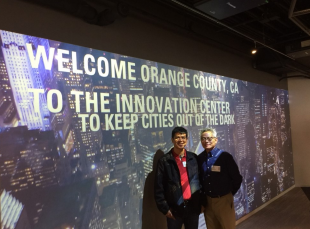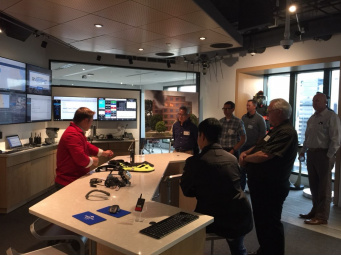The following article is from the SystemWatch Newsletter published by the Orange County Sheriff Department Communications and Technology Division.
 As all of you know, we are in the midst of a major upgrade to our 800 MHz Countywide Coordinated Communications System (CCCS). This upgrade provides several key enhancements to the current system.
As all of you know, we are in the midst of a major upgrade to our 800 MHz Countywide Coordinated Communications System (CCCS). This upgrade provides several key enhancements to the current system.
First and foremost, it brings us into compliance with Project 25, or “P25,” for short. This standard will allow for even greater interoperability between various agencies so we can more easily communicate, in both routine and emergency situations. We will also see the advent of Over-The-Air Programming (OTAP) and Over-The-Air Rekeying (OTAR).
Once installed and up and running, OTAP will allow us to reprogram and provide radio updates “over-the-air.” In the past we had to physically “touch” each radio one at a time. OTAR will allow for the changing of encryption keys over-the-air. As with OTAP, this process was not able to be completed in the past without the physical reprogramming of each radio in person. In the future, these new technologies will be part of the system and updates will occur in the background without inconveniencing the end users.
 Last month we traveled to Elgin, Illinois to take delivery of almost $25 million worth of new radio infrastructure equipment. This process is commonly referred to as a “Staging Event” and allows us to review and test all of our remote site equipment in a “real-time, live environment” before officially taking delivery. The engineering team led by our Chief Engineer and Assistant Director, Steve Miller, consisted of Senior Telecommunications Engineers Jim Donovan and Erik Schull, and Telecommunications Engineer III, Eldwin Lajom and Andrew Pham.
Last month we traveled to Elgin, Illinois to take delivery of almost $25 million worth of new radio infrastructure equipment. This process is commonly referred to as a “Staging Event” and allows us to review and test all of our remote site equipment in a “real-time, live environment” before officially taking delivery. The engineering team led by our Chief Engineer and Assistant Director, Steve Miller, consisted of Senior Telecommunications Engineers Jim Donovan and Erik Schull, and Telecommunications Engineer III, Eldwin Lajom and Andrew Pham.
We spent a full day at the Motorola Staging Facility where we put all of the systems through a battery of tests to ensure the equipment was properly configured and optimized. This day concluded with our “customer acceptance” where we officially signed off and accepted the equipment. During our physical inspection of the over 100 racks of radio equipment, we did find several issues. Most of these, Motorola was able to address before shipment and some will be addressed and resolved during the installation process back home in Orange County. This is exactly why this process of review and testing is in place prior to sign-off and acceptance.
Once accepted, our equipment was wrapped up and shipped to Orange County on three semi-trucks. This new equipment will be installed over the next year as we continue to move forward with the upgrade of the CCCS.
 Our two-day trip also included a tour of the Motorola Production Facility, where many of our radios for the CCCS are assembled, tested and shipped from. We also toured the Motorola Solutions Innovation Center in downtown Chicago. This facility showcases some of the latest emerging technologies that Motorola is developing for the public safety market. It was a look into the window of the future as to where digital communications are headed. We are excited about the future and where it will take us.
Our two-day trip also included a tour of the Motorola Production Facility, where many of our radios for the CCCS are assembled, tested and shipped from. We also toured the Motorola Solutions Innovation Center in downtown Chicago. This facility showcases some of the latest emerging technologies that Motorola is developing for the public safety market. It was a look into the window of the future as to where digital communications are headed. We are excited about the future and where it will take us.
Our goal is to provide our first responders, and all of our users, with the best interoperable communications system possible, so when they key the mic, they can focus on the job at hand, and not wonder if their transmissions will get through.
Will there be a change to talkaround (T/A) channels?
In preparation for the Next Generation radio system upgrade, a massive distribution and reprogramming of the new Motorola APX user radio equipment is now underway on a Countywide scale, and will occur in phases over the course of the next few months. During this time, agencies may use the new radios, however, there will be a subtle difference.
All talkaround (T/A) channels on the reprogrammed radios will only work with other reprogrammed radios. If an agency is still working on the old radios, those same talkarounds will work only on nonreprogrammed radios.
Example: If “City A” has all their new APX radios programmed, they can utilize “White-TA” and communicate amongst themselves or with other new APX programmed radios. If neighbor “City B” is still on their old XTS radios or non-reprogrammed APX radios, communicating with City A on “White-TA” will not work due to the rebanded frequency change.
What is the time frame for the cutover of the upgraded system?
This cutover is a massive undertaking that is in progress concurrently with the FCC mandated rebanding project. With the addition of the rebanding project, we foresee the P25 cutover concluding in the last quarter of 2019. Since this cutover is occurring in phases, your agency may receive equipment and/or updates sooner or later than others, and at that point, you will also be provided with further training materials to review the changes/updates.
Credit: OCSD SystemWatch Newsletter